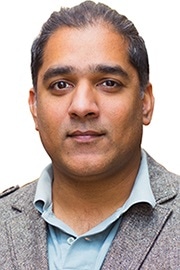 Interview conducted by Mychealla RiceAug 9 2016
Interview conducted by Mychealla RiceAug 9 2016Please can you give us a brief introduction about your company and the work you do?
Integrated Circuit Scanning Probe Instruments (ICSPI) is a spinoff from the University of Waterloo in Canada. After nearly 10 years of research into microelectromechanical systems (MEMS), we have developed the world’s first single-chip Atomic Force Microscope (AFM); a microscope that is so small that you would need another microscope just to see it. AFMs are among the highest resolution microscopes available today and are used in many different fields of science and technology. Through miniaturization and integration we are making this powerful instrument more accessible to those who can benefit most from it, while enabling new applications for experienced users. This technology is being commercialized as a small, simple, affordable desktop tool called the nGauge AFM.
What is a single-chip AFM?
The X/Y/Z scanners, the sensors, and the sharp tip of an AFM have all been integrated into a single 1x1mm MEMS chip. Apart from a coarse approach mechanism, this chip is the entire AFM. Extremely precise MEMS actuators provide sub-angstrom positioning while integrated piezoresistive sensors provide precision low-noise measurements. Unlike a conventional AFM which has large external scanners, a complex laser alignment system, miniscule probes to exchange, and a big vibration isolation table, the entire nGauge AFM system uses a single-chip AFM and some small, low-cost hardware to achieve results comparable to machines that cost 100x more.
What materials did you use to fabricate the AFM?
Complementary Metal Oxide Semiconductor (CMOS) is the most advanced and precise manufacturing process available today. It is used to manufacture processors, RAM, and camera sensors, as well as our AFMs. We take advantage of the extremely high resolution and reliability of CMOS, as well as the ability to batch fabricate at wafer scales, to produce a high quality AFM at a low price. The AFM tip is part of the CMOS stack and is made of aluminum, which naturally forms a very hard oxide. This aluminum oxide tip has been shown to produce over 10,000 images without any noticeable wear.
Why did you decide to develop the single-chip AFM?
It has long been known that the physics of scaling favor miniaturization of AFM instrumentation - smaller AFMs are faster, more immune to vibrations, and more stable. Several research thrusts have demonstrated these benefits over the years, including early STM chips from Stanford (Quate) and Cornell (MacDonald), the IBM Millepede program, and CMOS arrays of fixed AFM cantilevers (Hierlemann). Customers of conventional AFMs have been pushing instrument vendors towards higher resolution, but the size, ease-of-use, and cost have not been a priority; we think this is why AFMs have remained exclusive to niche applications. We developed the nGauge AFM to make nanotechnology more accessible, and to enable new applications that require robust, low-cost, high-speed measurements at the nanometer scale.
.jpg)
How did you manage the drastic scale down in size and cost?
Our research into CMOS-MEMS AFMs began with the systematic miniaturization of every component of an AFM down to the micrometer scale. We succeeded in integrating 3 degree-of-freedom actuation, resonant sensing, and a sharp tip (essentially the entire AFM) onto a single 1x1mm chip. We therefore eliminated the need for the bulky and expensive piezoelectric scanner stages and laser sensing systems used in conventional AFMs. The AFM chips are fabricated using CMOS technology, the same advanced technology that gives us processors, RAM, and virtually all microelectronics these days. CMOS manufacturing is vastly scalable and allows batch fabrication which drives down costs. An additional processing step is performed on the CMOS chips to "release" the micro-scale mechanical structures. These microstructures, called MEMS, are known to have extremely high resolution and sensitivity, making them perfectly suited for Atomic Force Microscopy.
How is it different or how does it compare to a conventional AFM?
While single-chip AFMs cannot currently achieve the sub-angstrom resolutions of today's best AFMs, their performance is on-par with mid-range systems. In fact, they are actually superior to traditional AFMs in many ways. Their small size leads to improved vibration immunity, lower drift, and higher scan speeds. The use of MEMS actuators eliminates piezo-related creep and hysteresis. The compact form-factor can lead to new applications by easily enabling integration into standard equipment like probe stations, electron microscopes, or assembly lines. For the first time it's also possible to place the AFM on the sample instead of the other way around. The complete integration also makes it straightforward to use as there are no laser to align, and the tips are easy to exchange since the whole AFM chip is disposable. The fact that the chip is disposable also means that it's simple to stay up to date with the latest advances, as improved AFM chip designs will be released periodically.
What are some of the applications?
AFMs are very versatile instruments that have many applications, and the nGauge AFM will enable unprecedented access to nanometer-scale imaging; we anticipate that this will enable numerous new applications. Any University or industry research lab that works on microfabrication, materials, surface science, nanotechnology, electroplating, grinding, polishing, etc, requires a tool that can image surfaces with nanometer precision. Many of these labs already either share an AFM or send their samples to an AFM lab to have them characterized. With the nGauge, everyone can have their own AFM whenever and wherever they need it.
The small size and versatility of single-chip AFMs also enables new applications through integration. An electrical probe station can be turned into an AFM, allowing electrical measurements and imaging on the same platform. A single-chip AFM can be integrated into an SEM to provide nanometer-scale topography information that complements SEM data. A small stage has been designed such that the AFM is placed on your sample, not the other way around. Large arrays of AFMs can be integrated to generate high-throughput metrology solutions. The possibilities are endless.
.png)
How will it impact research? Please could you tell us a few case studies where the single-chip AFM is achieving results.
The nGauge AFM is approaching the same resolution as many high-end conventional systems; almost anything that a conventional AFM can do, the nGauge can to. We are able to resolve single-walled carbon nanotubes, DNA, and the 67nm pitch of collagen, so any researchers who regularly use AFMs and have to compete for paid AFM time or wait for weeks while they send off their samples for imaging can now work on their own terms.
There are many small companies that conduct research that could greatly benefit from access to an AFM. We are currently working with two startups that are using the nGauge to help better understand their work which will ultimately shorten their time to market, improve their quality control, and result in a better product. Before nGauge, it was much more difficult for small companies to access the instruments that they need to succeed.
What will the single-chip AFM mean for the future of the Industry?
Single-chip AFMs will transform the way we interact with things at the nanoscale by making a powerful nanotechnology tool accessible to everyone. This technology can be used as a standard research tool, but it can also be used to quickly and precisely measure the surface roughness in a polishing or lapping process, the quality of an electroplated film, and the scratches and digs in optics. These AFMs can be integrated into an assembly line to measure the thickness of a deposited thin film, the quality of hard-disc read heads, or the distribution of nanoparticles on a surface. Never before has the ability to make nanometer measurements been so accessible and affordable.
Where can our readers go to find out more?
Anyone interested in learning more about the nGauge AFM can visit our website at icspicorp.com, or contact us at [email protected].
About Dr. Neil Sarkar
Neil Sarkar is president and co-founder of ICSPI. He has over 20 years of experience in the field of MEMS and microelectronics. He received his PhD in Electrical Engineering from the University of Waterloo in 2013.
About Duncan Strathearn
Duncan Strathearn is the Director of Product Development at ICSPI Corp. He received his BASc degree in Nanotechnology Engineering from the University of Waterloo in 2013. 
Disclaimer: The views expressed here are those of the interviewee and do not necessarily represent the views of AZoM.com Limited (T/A) AZoNetwork, the owner and operator of this website. This disclaimer forms part of the Terms and Conditions of use of this website.